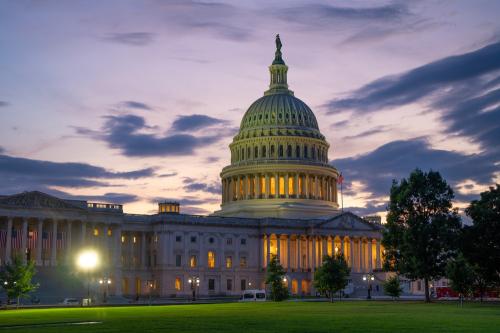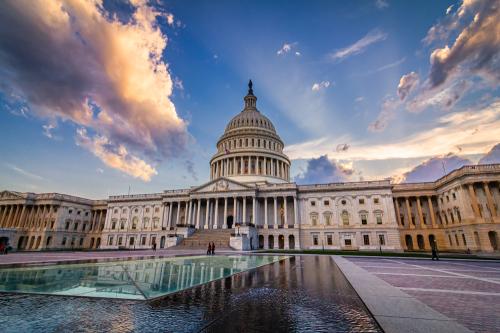New papers presented at the Brookings Panel on Economic Activity (BPEA) take an in-depth look at the economic landscape, offering fresh insights on how monetary and fiscal policy should work and how people feel about their economic status. Justin Wolfers, co-editor of the Brookings Papers on Economic Activity, notes that the papers examine several key topics for a comprehensive view of our economy today.
TRANSCRIPT
Hard economic times will continue for many Americans
“The research paper by Krueger and Mueller is just incredible! We are, for the first time ever in the United States, facing not only high unemployment, but high levels of long-term unemployment. People are unemployed now six, nine, and twelve months. The question is, ‘are those people going to be able to be reintegrated back into the work force? Are the long-term unemployed different from the short-term unemployed?’
In order to learn about this the authors went out and actually ran surveys of thousands of short- and long-term unemployed people. They didn’t just run one survey, they went back to these people every week. They asked them how much they had searched for work over the preceding week; they asked them how much they had searched for work yesterday; they asked them how they felt about this, as well.
You get a very stark picture. The longer someone is unemployed, the less likely they are to search for work; the more miserable they find searching for work; the more miserable they find the rest of their lives. This is true throughout the duration of their unemployment. So even once unemployment insurance runs out, you don’t see any of these behaviors change – so less job-searching, less effective job-searching, and greater misery among the long-term unemployed. This is really a huge cause for concern when we think about the recovery going forward. Are these folks going to be in a position that they can get out there, get active and find the jobs once they start getting created?”
(1:29)
Half of Americans are “Financially Fragile”
“It is a beautiful model for economic research. You take a first-order question – ‘are households out there able to cope with the financial shocks that are hitting them?’ – and you go out there and you just gather new data, and this is what [Annamaria Lusardi, Daniel Schneider and Peter Tufano] did. They went out and they said to U.S. households, ‘what if you had to come up with $2,000 within the next month?’ Think about that as sort of the cost of a shock transmission on your car. The amazing thing is that just about half of U.S. households said they could not come up with the money.
The authors repeated the same question, actually, in several different countries around the world. The Canadians were much more likely to [be able to come up with $2,000]. Maybe a quarter of [Canadians] had difficulty coming up with an extra $2,000 a month. And they have a whole bunch of other countries. It is very difficult to figure out exactly which countries are going to be more and less fragile, but it is absolutely clear that U.S. families are incredibly fragile. This is a problem that is not just one of the poor. When you look in the data at what looks like a middle class family, if they get hit with an unexpected shock (you can imagine your roof falling in, or something like that) they are really not in a position to deal effectively with it at all.”
(2:43)
The German labor market miracle is really a mirage
“The German unemployment miracle is…well it is incredible! Germany had a recession just like the United States did. In fact, if you look at GDP statistics it had a worse recession. But then go and have a look at the unemployment rate. What we saw in the United States is that unemployment has doubled. In Germany it barely rose. In fact employment today is at about the same level it was pre-recession. So the question is – why?
[Michael Burda and Jennifer Hunt] think that about one-third of this might be, actually, something less miraculous – that the German manufacturers were actually just not so excited by the boom. So hiring in Germany had not been so strong leading up to the boom, which means that firing when the boom ends doesn’t have to be so strong either. A lot of people talked about wage moderation. There has been a lot of labor market reform in Germany. The authors think maybe that is one-tenth of the story, but really there has not been that much wage moderation.
The really important and interesting thing that has happened in Germany is that while hours-worked in the economy have fallen quite substantially, the number of people employed has not. What has happened is the average number of hours worked has declined allowing everyone to keep their jobs. Figuring out exactly what is going on there is somewhat difficult. Germany is quite famous for having a work-sharing system, and there is a lot of discussion about work-sharing (potentially) in the United States as well, so that instead of cutting off one in every ten of your workers, you have all ten of them reduce their hours by one-tenth.
The other thing that has happened in Germany is the use of overtime accounts. What would happen is you could ask your workers to work harder during the boom and they would build up a balance in their overtime accounts. You’re not paying them overtime; you are just building up a balance of extra hours that they have worked so that when the recession hits, you just run down that balance. You say, ‘oh, well I already owe you a few hundred hours – for the next few weeks just come in ten hours fewer.’ So that then made it a lot easier for the Germans to cut the number of hours for each worker rather than cutting the number of workers. That is what kept employment levels high despite the fact that the American economic shock there has been just about as large.”
(4:56)
Quantitative Easing worked before and it should work now
“For a monetary economist it feels like we live in extraordinary times. The Fed now cannot move interest rates any lower, so it is QE2 (Quantitative Easing). What they are trying to do by that is not move the short-term interest rate, but move the longer-term interest rates on five and ten year bonds downwards. It feels like brave times! We have never tried this before! As a little-known historical fact, in turns out we tried this actually back in 1960. President Kennedy, a lot like President Obama, was elected during a recession. He inherited a recession. President Kennedy, at the time, did not want to try and use monetary stimulus – which is the normal short-term interest rate – because he was worried about the balance-of-payments. Instead what they tried is something that became known as “Operation Twist” (named for the dance craze at the time). “Operation Twist” was an attempt to reduce long-term interest rates instead of short-term interest rates (which is what the Fed normally does).
In fact, if you look at “Operation Twist” Eric Swanson shows, it is remarkably similar to what we call today “QE2.” So given this remarkable historic episode, Swanson is able to go back through and look at the remarkable similarities and ask ‘well, given what happened with “Operation Twist,” what do we think is going to happen as a result of QE2?’ His estimates suggest that “Operation Twist” succeeded in reducing long-term interest rates by, maybe, 15 basis points. That is one-sixth of a percentage point. That sounds pretty small, but remember that is the effect on long-term interest rates. We are used to thinking about changes in short-term interest rates. Reducing a long-term interest rate by about one-sixth of a percentage point is actually what would normally happen if the Fed reduced short-term interest rates by a full percentage point. So he suggests that “Operation Twist” had an effect that was roughly similar to what we would expect if the Fed reduced interest rates by one hundred basis points (or, equivalently, one percentage point). That suggests that mayeb we should be optimistic that QE2 is actually going to do something.”
(6:53)
“QE2 is actually a part of another paper in this conference. Greg Mankiw and Matt Weinzierl look and they ask, ‘when is it that we should be relying on fiscal policy and when should we be relying on monetary policy?’ What they do is they decide that macroeconomists so often write down complicated models and then we lose track of what is going on. So they write down the simplest mathematical representation of the economy they can. They come up with, at first, fairly obvious insights but you can see where they come from. The first insight is that most of time we should rely on monetary rather than fiscal policy. The logic here is that fiscal policy is good at getting us back to the level of GDP that we want, but it changes the composition of GDP. If we use fiscal policy we end up with more roads and parks, whereas if we use monetary policy we each just do a little bit more of spending. So most of the time, we [should] use monetary policy. If we cannot use monetary policy then something like QE2 makes a lot of sense. If we eventually run out of ammo with QE2, that is the point at which they say we should think about fiscal stimulus. If we have got to do fiscal stimulus, they say we should do this with investment credits instead of building more roads and parks.”
The Brookings Institution is committed to quality, independence, and impact.
We are supported by a diverse array of funders. In line with our values and policies, each Brookings publication represents the sole views of its author(s).



Commentary
A View of the U.S. Economy
March 17, 2011